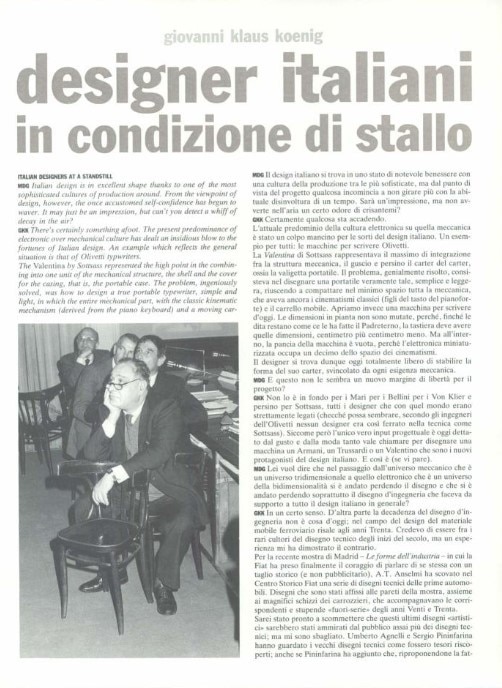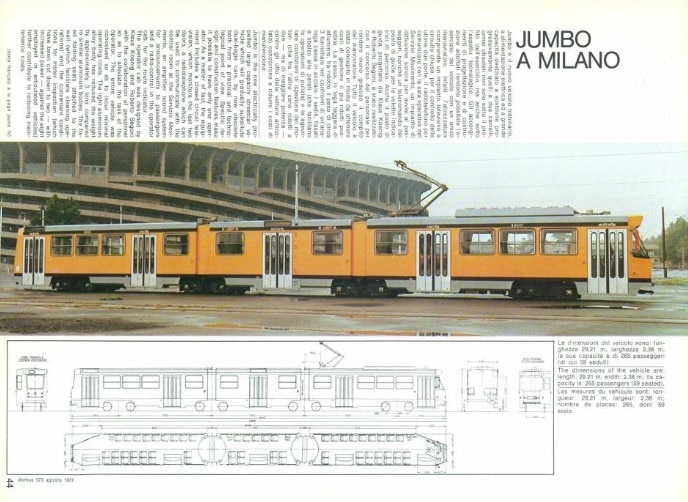Giovanni Klaus Koenig, born in Turin in 1924 but Florentine by identity − passing away in Florence in 1989 − was a man of profound interdisciplinary culture, deeply engaged in architecture and design, as well as graphic design, cinema, music, and theater. Koenig consistently advocated for a humanistic vision of technical progress serving social evolution, placing immense trust in the social and collective role of design.
For Koenig, design was primarily a system of thought that rationally optimized the processes of production and usage of everyday objects. He defined it as “design for the community,” or “design of all those elements that are not private property and exclusive to someone, but rather things that are used and not bought or owned.” Regarding this sensitivity and commitment to design, it’s worth recalling another figure who, although more internationally known − primarily among professionals of the field − explored similar themes during the same period of time, even if with less design experience: Victor Papanek, author of the legendary book Design for the Real World (1971).

He dedicated the first half of his professional life to architecture, beginning in the early 1950s under Michelucci and then with Leonardo Ricci, first as a collaborator and then as a partner, for numerous architectural projects. His career in architecture was marked by his involvement, both from a human and a design perspective, to the Waldensian Evangelical Church – of which he was an active member – and his academic focus on semiotics, language, and communication. In the late 1960s, Koenig transitioned to design for the second half of his life, a field he sarcastically viewed design as “a little less sad than contemporary architecture.”
Koenig provided various definitions of what constituted true design, emphasizing true design consists in “strong interactions between scientific discovery, technological application, good design, and positive social effects.”

His most famous book dedicated to this new awareness, Design is a Bat, Half-Mouse and Half-Bird, – so called from one of his ironic and desecrating definitions − was posthumously published in 1991 and is a collection of articles and essays on the history and theory of design. The book addresses key themes of his critical practice – philosophy, aesthetics, craftmanship, avant-garde movements, and kitsch – of the quality of metropolitan life, urban furniture design – his concept of the city as a communications system – as well as design related to public and private transportation – with proxemic readings and historical profiles of train, streetcar, bus, automobile, and motorcycle designs.
For Koenig, design was primarily a system of thought that rationally optimized the processes of production and usage of everyday objects.
His work on transportation design was the one that also directly engaged him as a designer, particularly with his colleague and friend Roberto Segoni.
In addition to the development of trains and subways – including the electromotors for Rome’s Line A, which earned an honorable mention for the 1979 Compasso d’Oro − their most renowned – and most criticized − work is the 1976 Jumbo Tram for the Milan ATM. It was a technologically innovative and aesthetically radical design for a surface light subway, featuring an asymmetrical profile to better navigate wide-radius curves and optimize internal space and functionality by lining up all the doors and having them adhering to the landing dock. This extraordinary design remains a distinctive feature of Milan’s streets today after fifty years – even though with some adjustments.

A new generation of scholars decided to address the legacy of the way of thinking of an author who touched and left marks in Italian architecture, design, didactics, history, criticism and design theory at a recent conference on the 100th anniversary of his birth, held recently in Florence at the Faculty of Architecture.
Koenig’s cultural production and inputs were so rich − he was a man of great spirit, militant critic and refined polemicist who collaborated assiduously with Domus, Casabella, Modo, Ottagono − that we wish our readers the curiosity of discovering even just one of his writings, which often had memorable titles, for example, Prolegomena, parerga and paralipomena. On the history of the twenty architects called to consult at the bedside of the Lingotto (Domus 652 July 1984).
Or, for more in-depth readings, we suggest the volume with the records of the conference just held at the University of Florence, GKK 100. Giovanni Klaus Koenig in Twentieth-Century Design Culture, which will be published at the end of the year.
Opening image: Portrait of Giovanni Klaus Koenig from Wikipedia

Innovation and sustainability in building materials
The new range of lime-based thermal plasters by Röfix is designed to provide advanced insulation solutions.


















